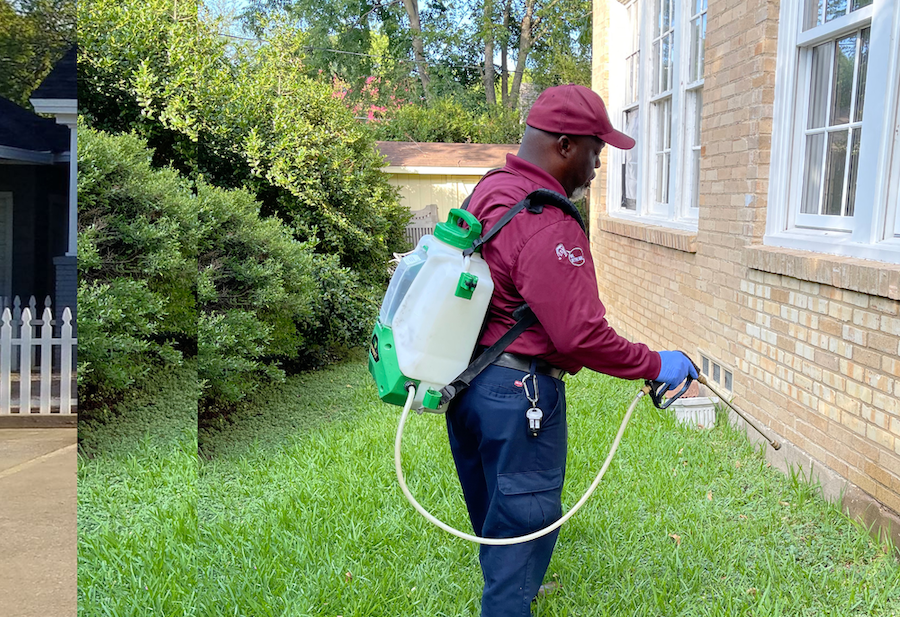Experienced A1 Exterminators Charlotte NC - Quick and Trustworthy Solutions
Experienced A1 Exterminators Charlotte NC - Quick and Trustworthy Solutions
Blog Article
Bed Pest Therapy Breakdown: Comparing Chemical Vs. Non-Chemical Solutions
In the realm of insect control, specifically when taking care of the relentless issue of bed pests, the option between chemical and non-chemical treatment options can be a critical one. Both strategies use unique advantages and drawbacks, influencing aspects such as performance, safety and security considerations, and overall cost. By analyzing the nuanced information of each method, a clearer understanding of which path to seek in attending to a bed pest problem can be obtained.
Effectiveness of Chemical Therapies
Chemical treatments for bed bug problems have actually been widely recognized for their potent and fast efficiency in eliminating these bugs. When considering the performance of chemical treatments, it is important to comprehend that they can give a complete and quick service to a bed bug problem.
Additionally, chemical therapies have the advantage of supplying residual impacts, suggesting that they can remain to remove bed pests even after the first application. This residual activity is specifically advantageous in combating any kind of possible re-infestations. In addition, the quick activity of chemical treatments can bring alleviation to people facing serious bed bug invasions, allowing them to reclaim control of their living rooms rapidly.
Security Worry About Chemical Solutions
One crucial aspect that requires careful consideration when using chemical services for bed pest treatment is ensuring the security of passengers and the setting. Exposure to certain chemicals used in bed insect treatments can lead to respiratory issues, skin irritation, or other adverse reactions, specifically in individuals with pre-existing conditions or sensitivities.
Furthermore, the ecological influence of chemical options is one more significant factor to consider. Some pesticides used in bed bug therapies might be dangerous to useful bugs, wild animals, and ecological communities if they seep right into the soil or water systems. It is crucial to use chemical treatments judiciously, adhering to security guidelines, and considering much less harmful choices to reduce these threats and make certain the efficient and secure monitoring of bed bug infestations.
Advantages of Non-Chemical Techniques
Considering the potential security problems and ecological effect connected with chemical options for bed bug treatment, discovering non-chemical approaches provides an appealing choice with a number of unique benefits. Non-chemical therapies are eco friendly, as they do not add to air or water air pollution, making them a sustainable selection for bug control.
In addition, non-chemical options can be efficient in targeting bed bugs, including hard-to-reach areas where chemical treatments might not penetrate - A1 bed bug exterminator charlotte. Techniques such as heat treatment, vacuuming, steam cleansing, and mattress encasements provide detailed obliteration without the usage of unsafe chemicals.
Limitations of Non-Chemical Treatments

Additionally, non-chemical treatments commonly need numerous applications to accomplish successful eradication. This can be lengthy and may not constantly ensure full use this link removal of all bed insects and their eggs, particularly in hard-to-reach or concealed places.
Additionally, the success of non-chemical therapies heavily relies on appropriate application and thoroughness, which can be challenging for individuals without specialist know-how. Poor application home bug extermination of non-chemical approaches may result in insufficient obliteration, bring about persistent infestations and the demand for additional therapies.
Therefore, while non-chemical treatments have their advantages, it is necessary to acknowledge these constraints and consider them when figuring out the most effective method for managing bed insect problems.
Price Comparison: Chemical Vs. Non-Chemical Options
Provided the constraints related to non-chemical therapies, a vital aspect to examine in the context of bed bug administration is the expense contrast in between chemical and non-chemical choices. Chemical treatments typically include the application of pesticides by specialists, which can range from $250 to $900 per space, relying on the severity of the problem and the size of the area to be dealt with. In contrast, non-chemical therapies like heat therapy or vapor can be extra costly, with prices ranging from $1,000 to $6,000 for a whole home. While the preliminary price of chemical treatments might seem reduced, multiple therapies might be called for to completely eliminate the invasion, potentially raising the total expense. On the various other hand, non-chemical alternatives might provide an extra environment-friendly and lasting service, although they can be cost-prohibitive for some people. Inevitably, when thinking about the cost of bed pest therapy options, it is necessary to consider the upfront expenses versus the efficiency and lasting sustainability of the picked approach.
Final Thought

Taking into consideration the potential security worries and environmental effect associated with chemical options for bed pest therapy, checking out non-chemical approaches offers an appealing alternative with a number of distinct advantages.Offered the constraints connected with non-chemical treatments, a necessary aspect to examine in the context of bed bug monitoring is the expense contrast between chemical and non-chemical options. In contrast, non-chemical treatments like warm treatment or vapor can be much more costly, with costs ranging from $1,000 to $6,000 for an entire home. While the preliminary expense of chemical treatments may appear lower, several therapies may be called for to totally eliminate the problem, possibly boosting the general expense.In verdict, when comparing chemical and non-chemical bed bug treatment alternatives, it is essential to consider efficiency, security, benefits, limitations, and expense.
Report this page